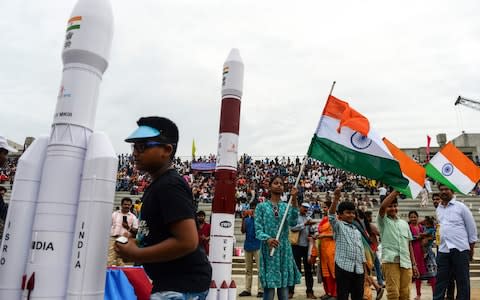India launches Chandrayaan spacecraft in bid to become fourth country on the Moon

India has successfully launched its second unmanned mission to the moon which, if successful, will see the country become the fourth to reach the moon.
The Indian Space Research Organisation (ISRO) said it successfully launched Chandrayaan-2 into orbit at 2.43 pm local time on Monday from the Sriharikota Range space station in southern India.
Applause erupted in the ISRO control room within seconds of the launch that was broadcast live on Indian news channels.
Narendra Modi, India’s prime minister, praised Chandrayaan-2 as "unique". Mr Modi announced last year that ISRO would execute a manned space mission by 2022 to celebrate the 75th anniversary of India's independence.
The Chandrayaan-2 mission will cost £120 million, while the manned mission will reportedly require the ISRO's funding to be increased dramatically from £1.3 to £4 billion.
Critics have questioned India's space ambitions, arguing that it is an inappropriate way to spend money in a nation that receives financial assistance, and where millions of people struggle with crippling poverty, malnutrition and crumbling infrastructure.
“India is a competent event manager capable of undertaking individual projects efficiently, but incapable of sustaining any long term developmental endeavours,” said Seema Mustafa of the Centre for Policy Analysis in New Delhi.

She added that such "overreach" was typical of all successive governments that prided themselves on registering milestones rather than providing hundreds of millions of Indians with food, clean water, power, health, education and employment.
Officials stoutly defended the mission, saying scientific research could not be compartmentalised. Yesterday, the mood at the Satish Dhawan Space Centre on India's east coast, was jubilant.
“After a technical snag, we bounced back with flying colours,” said ISRO chairman Kailasavadivoo Sivan after takeoff. He was referring to the earlier countdown on 15 July being halted 56 minutes before its scheduled blast-off following a snag in which a helium gas bottle in the rockets cryogenic engine was reportedly found to be faulty.
Mr Sivam said the glitch was fixed within 48 hours. Launched aboard the domestically developed Geosynchronous Satellite Launch Vehicle Mark III, the 640 ton spacecraft is due to touch down on the moon after a 48-day journey on 6 September to begin its investigative missions, officials said.

It will also be first such mission to the moon’s south pole to map its topography and look for water. And if successful, it would make India the fourth country after China, Russia and the US to execute a ‘soft’ controlled landing on the moon and deploy an investigative rover onto its surface.
Chandrayaan-2 - Sanskrit for "moon vehicle" - comprises three distinct parts: the ‘orbiter’ with a mission life of one year built to take images of the lunar surface and ‘sniff’ the atmosphere, and the lander - named Vikram, after ISRO’s founder - which carries within its belly a six-wheeled rover to analyse the lunar soil.
In its 14-day lifespan the rover is capable of travelling 550 yards from the lander and sending data and images back to earth for analysis. “India can hope to get the first selfies from the lunar surface once the rover gets going,” Mr Sivan said before the aborted July 15 mission.
The mission involves some 1,000 engineers, scientists and technicians and is led by two women Muthaya Vanitha, programme director, and Ritu Karidhal, mission director.
India's first lunar mission, Chandrayaan-1, which launched in 2008, did not land on the moon, but carried out the most detailed search for water on it using advanced radar technology. Six years later India successfully launched a data and image gathering mission to Mars to determine how Martian weather systems function.

